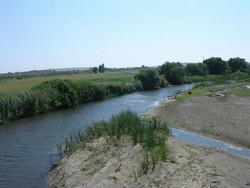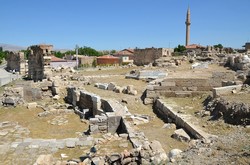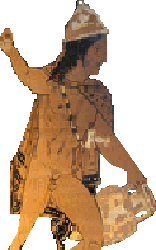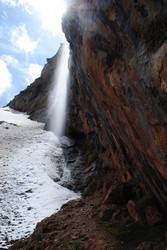SACRED SPRINGS: ANALOGUES FOR ATLANTIS' HOT AND COLD WATER SOURCES
And Poseidon himself set in order [...] the central island, bringing up from beneath the earth two springs of waters, the one flowing warm from its source, the other cold, and producing out of the earth all kinds of food in plenty. [Crit. 113e].
One of the signal characteristics of Plato's Atlantis is this existence of two springs bearing warm and cold water on its central acropolis. These are described in the Critias [117ab] as being: -
The purpose of this essay is to provide an overview of the motif of springs - especially twin hot and cold springs - and other bodies of water in Greek mythology.
THE ILIAD: SOURCES OF THE SCAMANDER
The most obvious literary source for the springs in Atlantis is Homer's Iliad, which provides a brief description of two springs near the walls of the famous Troy [22.145-156]: -

Here we have the same configuration as those in Atlantis, albeit they are just outside Troy's walls, whereas the springs in Atlantis are at the very centre of the city on the acropolis. Homeric influence may also be behind the numbering of the fleet of Atlantis, said to be formed of 1,200 vessels [Crit. 119b], which accords well with the Greek force from the "Catalogue of Ships" [Iliad 2.494-759], which numbers 1,185. Herodotus, too, may have been influenced by the Iliad in his according the Persian armada a strength of 1,207 ships [7.89].
OTHER TWIN SPRINGS IN HOMER

In terms of precursors for the idea of twin springs (though without any difference in temperature), we find twin springs within the garden of the Phaeacian king Alcinous in Homer's Odyssey [7.129-131]. Here, "there are two springs in the orchard, one flowing through the whole garden, while the other runs the opposite way, under the courtyard sill, near where the people of the city draw their water, towards the great house," with another spring noted in a grove sacred to Athena nearby [6.292-294]. Coincidentally, the name of the Phaeacians' former home of Hypereia is also the name of a spring in Thessaly mentioned in the Iliad, where it is on one occasion paired with a second spring, Messeïs [6.457], while Hypereia is placed within the land ruled by Euaemon, alongside "Asterium and the white towers of Titanus" [2.734-737].
The spring in found in the grove of Athena, which is made up of poplar trees, which also appear in other descriptions of sources of water from the Odyssey: poplars stand around a cave from which a stream emerges on the small island facing the harbour on the island of the Cyclopes [9.141-143] and poplars are one of the species forming the woodland around the cave inhabited by Calypso on Ogygia [5.64], close to which "four neighbouring springs, channelled this way and that, flowed with crystal water" [5.70], as well as appearing at the edge of the island where they "rose to the sky" [5.239], reminiscent of the "trees of all kinds that were of marvellous beauty and height because of the richness of the soil" in the sacred grove of Poseidon on the Atlantean acropolis [Crit. 117b]. The water management and tree plantations noted in the Critias [117ab] bear a strong resemblance to the descriptions of Ogygia and Scheria in the Odyssey.
Additionally, perhaps one of the most obvious sources for the difference in the temperatures for the springs on the Atlantean acropolis can also be found in Homer's description of Odysseus in the land of the dead beyond Oceanus [10.513-514], where he comes to: -
As the name suggests, the Pyriphlegethon was, in stark contrast to its gloomy underworld peers, envisaged as being a river of flame. Plato pairs it with the Cocytus in the Phaedo [113c], where the Pyriphlegethon forms a lake of mud and water similar in some respects to the shallow and muddy nature of the Atlantic as a result of the sinking of the island.
THE ASBAMA NEAR TYANA

Moreover, Croatian classicist Tomislav Bilić notes two further occurrences of juxtaposed hot and cold bodies of water, both of which postdate Plato. In his biography of the religious figure Apollonius of Tyana [1.6], Philostratus makes mention of the Asbama, a spring near Apollonius' home town, the temperature of which is dependent upon the character of the one who would slake his thirst with its waters: -
ILLYRIA AND THE "LAND OF BLISS"

Towards the end of antiquity, Priscianus speaks about a sacred fountain associated with Cadmus and Harmonia's exile in Illyria, which Bilić suspects "has a complex mythical background and belongs properly to some early concept of the Adriatic as the Land of Bliss," adding portentiously that "the abode of the serpentine hero from Thebes seems to be located in the West, which is a close parallel with the western abode of serpentine Typhon, Ophion, or Cronus himself." The "Sacred fountain, at the same time unnaturally cold and miraculously hot" would then be properly located in the furthest west. As Bilić notes elsewhere: "[a]mong the earliest accounts of the western exile is presumably Cronus' banishment to the Adriatic. It could be claimed that Cronus and Rhea were associated with the Adriatic in an age when the Greeks considered it the western edge of the known world, this being the earliest layer of their mythical geography."
POMPONIUS MELA AND THE FORTUNATE ISLES
A later conception of the "land of bliss" places it in the furthest west, where the Roman writer Pomponius Mela mentions two springs possessed of strange and miraculous powers on the Fortunate Isles, which, in this instance, appear in his text to signify the Canary Islands [3.102]. The section is worth quoting in full: -
Significantly, we have here a paradise in the Atlantic, whose "golden age"-like state (extreme fruitfulness providing ample foodstocks to the inhabitants) echoes Plato's description in the Critias [esp. 115ab; 118e].
This passage also bears similarities to Theopompus' two rivers of the western extreme of the outer continent in the Meropis: -
This duality reflects the dual nature of the two major cities of the continent as described by Theopomus: warlike Machimus and lawful Eusebes.

PAUSANIAS ON THE STYX AND ALYSSUS
In the real world, Pausanias discusses the opposite natures of two Arcadian rivers, the Styx (whose implications are self-explanatory, given that this stream shares its name with the dread river of the underworld) [8.17.6-18.6] and the Alyssus, which reportedly possessed curative powers [8.19.2-3] and ran near a complex of medical baths based around a cave dedicated to Artemis Hemerasia [8.18.7-8].
THE ORPHIC GOLD LEAVES
Bilić also notes "Orphic" sources: -
Mnemosyne is the fountain of remembrance and is thus clearly drawn into opposition with the fountain of Lethe, mentioned by Plato in the "Myth of Er" [Republic 10.621a], which causes the souls of the deceased to forget their past lives during the process of metempsychosis.
PLUTARCH'S UNDERWORLD
Plutarch, in the De sera numinis vindicta [22], which is probably modelled on the Er myth, describes the underworld journey of one Thespesius of Soli, in which he encounters demons surrounding three pools: -
QRTJ: "SOURCES" OF THE NILE
It is also worth pointing out that, in Egyptian cosmology, the Nile emerged from the boundless waters of the Nun via two qrtj ("caves") on the island of Elephantine (a.k.a. Abu or Yebu). Jan Assmann associates the inundation, which has its origins in the cave, with the efflux of Osiris after his murder by Seth, with the Elephantine region associated with Osiris' wounded leg. E.A. Wallis Budge associated Elephantine with Kns.t, a location which is nowadays normally placed in Nubia which is mentioned in the Pyramid Texts [Unas 254.280] in terms reminiscent of the great meeting of the archons of Atlantis: -
A similar tradition about the Nile's founts was drawn to the attention of the historian Herodotus during his travels in Egypt [2.28.2-3]: -
Of particular significance in light of the Atlantis myth is Herodotus' report about his informant on this occasion: "no one that conversed with me [...] professed to know them, except the recorder of the sacred treasures of Athena in the Egyptian city of Saïs" [2.28.1] - suggesting that the traditions known at Saïs were indeed of ancient provenance, given the concordance with detains mentioned in the Pyramid Texts.
As a side note, the notion that the springs of the Nile travelled in different directions ("half the water flows north towards Egypt, and the other half south towards Ethiopia") is suggestive of an Egyptian provenance for the persistent theory by which the "Nile" came to be identified with West African rivers such as, for example, the Senegal and the Niger (for such seem to be what Euthymenes and the Nasamones refer to in these instances).
VOLCANOES?
The existence of a warm spring has been interpreted as possible evidence that Atlantis was volcanic, and thus probably met its demise in a volcanic event. Against this, however, it should be noted that Plato never specifically mentions volcanic action as the mechanism for the destruction of Atlantis (though, of course, he never provided a fully-detailed account of the island's destruction). For Plato's thinking on volcanoes, see the Phaedo [113b].
It must also be noted that hot springs are not necessarily a sign of volcanism: there are a number in the United Kingdom, which is not currently located on a tectonic hot zone.
The hot and cold springs have also been put forward as support for the Minoan hypothesis as warm and cold water channels have been excavated on the island of Thera. However, the likelihood that the Atlantis myth represents a memory of Minoan Crete and the Thera eruption is to be rejected on numerous other grounds.
